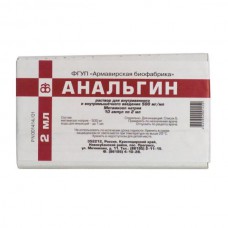Expiration date: 12/2026
Analgin
International name: Metamizole sodium (Metamizole sodium)
Group affiliation: non-narcotic Analgesic remedy
Description of the active substance (INN): Metamizol sodium
Dosage form:
capsules, solution for intravenous and intramuscular injection, rectal suppositories [for children], tablets [for children]
Pharmacological action:
NSAIDs, a derivative of pirazolona, mechanism of action not practically different from other NSAIDs (non-selectively inhibits COX and reduces the formation of Pg from arachidonic acid). Impedes pain extra - and proprioreceptive of pulse bundles Gaulle and Burdach, increases the threshold of excitability of thalamic centers of pain sensitivity increases teplootdachu. A distinctive feature is the low intensity of the anti-inflammatory effect, causing little impact on water-salt metabolism (delay of Na+ and water) and the gastrointestinal mucosa. Has analgesic, antipyretic and antispasmodic a (in respect of smooth muscles of urinary and biliary tract). The action develops in 20-40 minutes after ingestion and reaches its maximum after 2 hours.
Indications:
Febrile syndrome (infectious-inflammatory diseases, insect bites and stings - mosquitoes, bees, gadflies, etc., post-transfusion complications), Pain (mild to moderate severity): including neuralgia, myalgia, arthralgia, biliary colic, intestinal colic, renal colic, trauma, burns, decompression sickness, shingles, orchitis, sciatica, myositis, postoperative pain, headache, toothache, algomenorrhea, etc.
Contraindications:
Hypersensitivity, oppression blood (agranulocytosis, cytostatic or infectious neutropenia), hepatic and/or renal failure, hereditary hemolytic anemia associated with a deficit glukozo-6-fosfatdegidrogenaza, "aspirinova" asthma, anemia, lakopenia, pregnancy (especially in I trimester and in recent 6 ned), lactation.C caution. The neonatal period (up to 3 months), kidney disease (pyelonephritis, glomerulonephritis - including in history), long-term abuse of ethanol. In/in the introduction patients with systolic BP below 100 mm Hg.St. or instability of the circulation (e.g. myocardial infarction, multiple injuries, beginning with the shock).
Side effects:
From the urinary system: impaired renal function, oliguria, anuria, proteinuria, interstitial nephritis, urine staining in red. Allergic reactions: urticaria (including the conjunctiva and mucous membranes of the nose and throat), angioedema, in rare cases - malignant exudative erythema (Stevens-Johnson syndrome), toxic epidermal necrolysis (Lyell's syndrome), bronchospastic syndrome, anaphylactic shock. Organs of hematopoiesis: agranulocytosis, leukopenia, thrombocytopenia. Other: decrease in blood pressure. Local reactions: when the/m introduction of a possible infiltration at the injection site.
Overdose:
Symptoms: nausea, vomiting, gastralgia, oliguria, hypothermia, decreased blood pressure, tachycardia, dyspnea, tinnitus, drowsiness, delirium, impaired consciousness, acute agranulocytosis, hemorrhagic syndrome, acute renal and/or hepatic failure, convulsions, paralysis of the respiratory muscles. Treatment: gastric lavage, saline laxatives, activated carbon, conducting forced diuresis, hemodialysis, the development of convulsive syndrome in intravenous diazepam fast-acting barbiturates.
Method of application and dose:
Inside, 250-500 mg 2-3 times a day, the maximum single dose - 1 g daily - 3 g Single dose for children 2-3 years - 50-100 mg, 4-5 years - 100-200 mg, 6-7 years - 200 mg, 8-14 years - 250-300 mg, the multiplicity of purposes - 2-3 times a day. The/m or/in (especially severe pain): adults - 250-500 mg 3 times a day. The maximum single dose - 1 g daily - 2 g. Children appoint a rate of 5-10 mg/kg 2-3 times a day. Children up to 1 year the drug is administered only in/m Enter the solution for injection must be body temperature. Doses over 1 g should be administered. Required conditions for antishock therapy. The most common reason for a sharp decline in blood pressure is too high injection speed, in this connection, in/in the introduction should be conducted slowly (not faster than 1 ml/min), position of the patient "lying" under control blood pressure, heart rate and number of breaths. Rectal use - for adults - 300, 650 and 1000 mg. The dose for children depends on the child's age and the nature of the disease, it is recommended to use baby candles 200 mg from 6 months to 1 year - 100 mg, from 1 year to 3 years - 200 mg, from 3 to 7 years - 200-400 mg, 8 to 14 years - 200-600 mg. After the administration of suppository child should be in bed.
Special instructions:
In the treatment of children under 5 years and patients receiving cytotoxic drugs, receive Metamizole sodium should be done only under medical supervision. Intolerance occurs very rarely, but the threat of anaphylactic shock after/in the introduction of the drug is relatively higher than after ingestion of the drug inside. Patients with atopic bronchial asthma and hay fever have an increased risk of allergic reactions. In patients receiving metamizol sodium may develop agranulocytosis, and therefore the detection of unmotivated rise in temperature, chills, sore throat, difficulty swallowing, stomatitis, as well as the development of the phenomena of vaginitis or proctitis required the immediate withdrawal of the drug. Long-term use must be monitored picture peripheral blood. Not be used to relieve acute abdominal pain (to determine cause). For the on/m introduction you must use a long needle. Perhaps urine staining in red due to separation of the metabolite (does not matter).
Interaction:
Due to the high probability of the development of the pharmaceutical incompatibilities do not mix with other drugs in the same syringe. It enhances the effects of ethanol simultaneous application with chlorpromazine or other phenothiazine derivatives can lead to the development of severe hyperthermia. Radiopaque drugs, colloidal blood substitutes and penicillin should not be used during treatment with Metamizole. When concomitant administration of cyclosporine decreases the concentration of the latter in the blood. Metamizole, displacing connection with protein oral hypoglycemic drugs, indirect anticoagulants, corticosteroids and indometacin, increases their activity. Phenylbutazone, barbiturates and other heatinduced while appointing reduce the effectiveness of metamizol. Simultaneous administration with other non-narcotic analgesics, tricyclic antidepressants, hormonal contraceptive drugs, and allopurinol may lead to increased toxicity. Sedative and anxiolytic drugs (tranquilizers) increase the analgesic effect of metamizol. Tiamazol and cytostatics increase the risk of leukopenia. The effect of increasing codeine blockers H2-histamine receptors and propranolol (slow inactivation). Mielotoksicskie drugs increase the manifestation gematotoksichnosti drug.
The description of the drug Analgin is not intended to assign treatment without a doctor.


